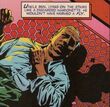Webspinners Tales of Spider-Man #12
Background
The Chameleon is dead, killed by his own hand after his last, desperate effort to reach out is rebuffed by Spider-Man. How can Peter Parker survive the knowledge that his long-time enemy's blood is on his hands?
Story 'Perchance To Dream'
Webspinners Tales of Spider-Man #12
| Editor: | Ralph Macchio |
| Writer: | Paul Jenkins |
| Pencils: | J.G. Jones |
| Inker: | Jimmy Palmiotti |
| Cover Art: | J.G. Jones |
| Reprinted In: | Peter Parker: Spider-Man (Reprint TPB) #1 |
As he walks off the bridge, rain starting to fall, Peter Parker can only come to one conclusion: the Chameleon's death was his fault. The man was alone, lost, trying to find someone who he could turn to, and Peter just laughed in his face. Just more guilt for a man burdened by too much already. He returns home, brushes off Aunt May, and collapses into a nightmare.
Within the dream, the traumas of his life unfold around him. He sees Captain Stacy die again, Harry Osborn, Kraven the mad Hunter, the baby, Ben Reilly, and all because of him. Then the death of Gwen Stacy, plummeting from the bridge, neck snapping as Peter's webline catches her. "Maybe if you'd let her fall, take her chances in the water . . . maybe you killed her." But the most pivotal is yet to come: the death of Uncle Ben. No matter how much he can possibly rationalize the others' deaths, (and let's be honest, the assorted supervillains deserve to shoulder the lion's share of blame) "he died because you were too selfish and lazy to prevent it. It was your fault, Pete. And as soon as you accept it, that's when you'll be free of it." Re-energized in the dream, Peter finds himself attacking several of his enemies, laughing all the way. Soon, he realizes that that way, losing himself in the fighting and Spider-Man persona, is too easy. He has to carry the burden of his life. "I know it's a big convoluted mess, but that's what you've become."
General Comments
Oh...kay....
Last issue I wondered how Jenkins & co would follow up on the Chameleon's sudden death. This certainly was a way to go. Peter's reaction is well done as he almost crumbles under the weight of his guilt, but on a whole the "dream resolution" was a bit contrived (not to mention overdone). I do like how he realizes that accepting his fault in Chameleon's death (as well as Uncle Ben's) gives him the strength to live with those burdens. And then how losing himself as Spider-Man as a way to deal with those burdens--not dealing with them, actually, but ignoring them--is too easy a fix. Act I of the clone saga certainly bears that theory out. The knowledge that he has to go forward and he has to look his mistake square in the eye and own up to it is a lesson well learned, but it is still a strange (and, unfortunately, superfluous) way to wrap up a three-issue storyline. Part three is done as well as can be expected, but it just isn't necessary to the story, IMHO.
Still, bonus points should go to the art team for using old comic book pages and integrating the old art into the new story for the flashbacks and dream sequences. Very nifty touch. And, again, a hearty thanks for using the REAL Spidey history. One-half web extra just for that!
Overall Rating 


An excellent two-issue story sprouts a decent but slightly hackneyed epilogue. Three webs.

